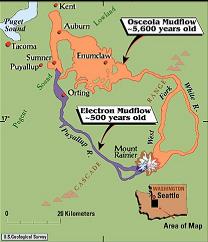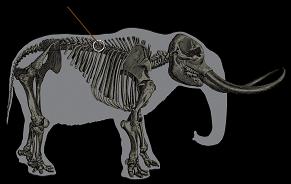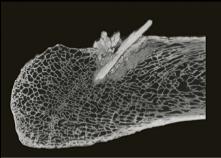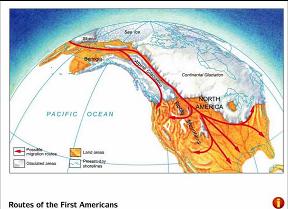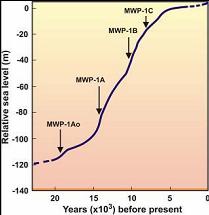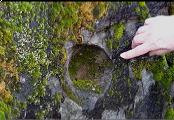Enumclaw: 6000 Years Ago
to the Mid-1800s
to the Mid-1800s
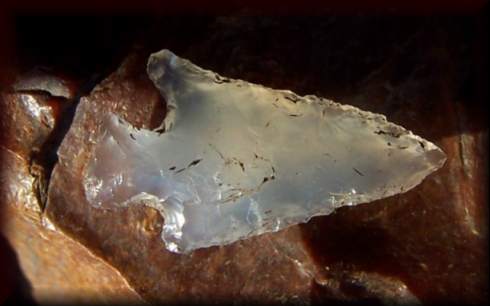
Imagine living in Enumclaw without a Plateau. The canyon-like contour of the land just east of town where the foothills suddenly begin would continue to Auburn, where it would meet Puget Sound. That all changed in a matter of hours with the Osceola Mudflow 5600 years ago. The river of mud turned into a lake of mud, forming the Enumclaw Plateau. And people were living here before that happened.
Archeological finds under one Enumclaw farm date back 6000 years. (1)
They indicate human habitation near our town, seventy-five feet below
the surface at the pre-mudflow level. Now 6,000 years is a difficult
amount of time to get your brain around. In 2013 our town celebrated its
first centennial , or was it its 60th centennial? Think of the Revolutionary
War and the founding of our country. 6,000 years is twenty-five times
as far back as that. When was Jesus born? Native American ancestors were
already in our area for two millenia by then. The Egyptian pyramids? More
than a thousand years before the first one, people were in our neighborhood.
They have been living here for a long time.
If that is hard to grasp, imagine living here 13,000 years ago. (2) That's
130 centennials. Glacial Period ice was still retreating from the area.
Then imagine heading toward Auburn for an elephant hunt. Various
tools on an Enumclaw Plateau site have been tentatively dated back
that far. And this is contemporary with the famous find near Sequim of a
mastodon skeleton with a spear point embedded in its rib. (3), (4)
We don't know much about the earliest peoples in the area, although advanced techniques, including DNA analysis, CT scanning, and mass spectrometers are narrowing down the time of their arrival. It appears the ancient ancestors of our local Native Americans crossed the Beringa Land Bridge around 16,500 years ago and migrated south at least a millenium after that, either by following an ice-free corridor east of the Rockies and fanning out in all directions, or by coming down the coast on foot and in primitive boats. We do know that sea level was about 300 feet lower at the time because of water locked up in glaciers. (5)
(We are making fresh history every day, but we are also continually expanding and refining our knowledge of the past. History is not a constant. It is not what has happened, but what we know of what has happened.)
Evidence of ancient human presence has been found in 19 archeological sites on the Enumclaw Plateau, and signs of houses were discovered at one place. All of these 19 sites have been disturbed and some almost completely destroyed by activity like the construction of ball fields by Southwood Elementary School and the development of a turf farm on the old Porter homestead. (6) A few sites are still relatively intact, and will benefit from careful study by tribal representatives and their selected archeologists. Of course, there are likely many more artifacts under the mudflow, and well preserved at that, but it is nearly impossible to know where to look.
One ancient artifact near here (Bonney Lake) remains in its original location
(although surrounded by a housing development) and is available for all to
see. Archeologists believe the Skystone, a large boulder deposited in the
last Glacial Period, was a calendar or astronomical observatory later carved
by the Puyallups or their predecessors. Various combinations of the twenty
holes line up with true north and the equinoxes. (7)
Muckleshoot ancestors lived in and near what is present-day Enumclaw between the White and Green Rivers. The tribe, named later for the prairie on which it was relocated, is comprised of descendents from the Duwamish and Upper Puyallups, which are branches of the Coast Salish people who inhabited a large area from the bottom of Vancouver Island, through the Puget Sound region and the Olympic Peninsula, and down the Oregon Coast.
Many of the native settlements and summer camps on the Plateau were in open spaces--manmade prairies kept clear by burning. The area had no natural prairies, so these sites allowed plants and wildlife not commonly found here to prosper--oaks, hazelnuts, blackberries, and camas roots. Elk preferred the open spaces for grazing, as they do today in fields adjacent to town.
In winter, ancestors of our local native population lived in villages near the rivers. Throughout the rest of the year, they traveled widely around the Plateau and well beyond it for hunting, fishing, clamming, and gathering. On these journeys, they maintained kinship and trade relationships with others from Puget Sound to the eastern slopes of the Cascades. (8) They used trails over passes, especially the Naches, to access food and other resources that weren't available here, while eastern groups, particularly the Yakama and Klickitat, came here for salmon. No doubt they passed through Enumclaw or near it on these excursions.
This pattern of life changed dramatically in the 1800s, especially in the decade from 1850 to 1860.
-----------------------------------------------------------------------
NOTES
1. http://www.historylink.org/index.cfm?DisplayPage=output.cfm&file_id=5095
2. "An as-yet unreported site approximately 70 air miles southeast of the Park [Mt Rainier National Park] on the Enumclaw Plateau . . . may eventually prove more illustrative of that early technology. There, Hedlund has tested a site where he found a lithic assemblage resting on a glacial recession till surface. The till surface has been tentatively dated geologically to about 13,000 B.P. [before present], possibly placing the site close in time to the Manis site" [near Sequim].
"The possible relationship of the Enumclaw assemblage to the obvious bone-working orientation at Manis is intriguing. It seems reasonable to suggest that the earliest cultural pattern on the Olympic Peninsula possessed, in addition to simple stone tools, a simple bone tool inventory which, being highly perishable, doesn't often survive in the archeological record of open sites except at water-saturated sites such as Manis. Continued excavation and analysis of sites like Manis and Enumclaw is necessary in order to achieve a fuller understanding of the earliest cultural pattern(s)."
http://www.nps.gov/history/history/online_books/olym/prehistory_ethnography/chap3.htm
3. "Chemical analysis of DNA and protein extracted from the spear point show that it was fashioned from mastodon bone. The hunters would have mounted the sharpened bone projectile at the tip of a wooden shaft and may have used a spear-thrower, or atlatl, to hurl it with more force. A hunter may have thrust it by hand, aiming for the heart or lungs. Mastodons weighed 4 or 5 tons and stood about 8 to 10 feet tall at the shoulder."
http://www.oregonlive.com/environment/index.ssf/2011/10/mastodon_hunting_site_from_138.html
4. "A suite of Accelerated Mass Spectrometer (AMS) radiocarbon dates were reported in 2011, on the purified bone collagen extracted from the mastodon rib in which the bone point is embedded, and from two different mastodon tusk fragments. These new dates range between 13,860-13,763 B.P.
http://archaeology.about.com/od/preclovissites/qt/Manis-Mastodon.htm
5. http://www.giss.nasa.gov/research/briefs/gornitz_09/
http://exhibits.pacsci.org/puget_sound/graphics/ps_glaciationsm.mov
A 30-second video showing changes in Puget Sound from a freshwater lake to a saltwater sound over the past 20,000 years.
http://pugetsoundlidar.ess.washington.edu/faults/Vashon_sm.mov
http://www.boston.com/whitecoatnotes/2012/07/11/native-americans-migrated-the-new-world-three-waves-harvard-led-dna-analysis-shows/uQRQdkkqMmzSW3LaArh0tM/story.html
6. Location and Cultural Assessment of Archaeological Sites on the Enumclaw Plateau in the Southern Puget Sound Lowland. An Abstract by: Gerald C. Hedlund.
http://www.alaskanartifacts.com/Enumclaw/Enumclaw_Wa.html
7. Skystone, a native astronomical observatory:
http://bonneylake-sumner.patch.com/articles/sky-stone-then-and-now
http://www.blscourierherald.com/news/44090877.html
8. http://www.muckleshoot.nsn.us/about-us/overview.aspx
More on Enumclaw archeological studies:
ftp://ww4.dnr.wa.gov/geology/pubs/ic107/parts/ic107_mt_rainier_guide_part1_1.pdf
Archeological finds under one Enumclaw farm date back 6000 years. (1)
They indicate human habitation near our town, seventy-five feet below
the surface at the pre-mudflow level. Now 6,000 years is a difficult
amount of time to get your brain around. In 2013 our town celebrated its
first centennial , or was it its 60th centennial? Think of the Revolutionary
War and the founding of our country. 6,000 years is twenty-five times
as far back as that. When was Jesus born? Native American ancestors were
already in our area for two millenia by then. The Egyptian pyramids? More
than a thousand years before the first one, people were in our neighborhood.
They have been living here for a long time.
If that is hard to grasp, imagine living here 13,000 years ago. (2) That's
130 centennials. Glacial Period ice was still retreating from the area.
Then imagine heading toward Auburn for an elephant hunt. Various
tools on an Enumclaw Plateau site have been tentatively dated back
that far. And this is contemporary with the famous find near Sequim of a
mastodon skeleton with a spear point embedded in its rib. (3), (4)
We don't know much about the earliest peoples in the area, although advanced techniques, including DNA analysis, CT scanning, and mass spectrometers are narrowing down the time of their arrival. It appears the ancient ancestors of our local Native Americans crossed the Beringa Land Bridge around 16,500 years ago and migrated south at least a millenium after that, either by following an ice-free corridor east of the Rockies and fanning out in all directions, or by coming down the coast on foot and in primitive boats. We do know that sea level was about 300 feet lower at the time because of water locked up in glaciers. (5)
(We are making fresh history every day, but we are also continually expanding and refining our knowledge of the past. History is not a constant. It is not what has happened, but what we know of what has happened.)
Evidence of ancient human presence has been found in 19 archeological sites on the Enumclaw Plateau, and signs of houses were discovered at one place. All of these 19 sites have been disturbed and some almost completely destroyed by activity like the construction of ball fields by Southwood Elementary School and the development of a turf farm on the old Porter homestead. (6) A few sites are still relatively intact, and will benefit from careful study by tribal representatives and their selected archeologists. Of course, there are likely many more artifacts under the mudflow, and well preserved at that, but it is nearly impossible to know where to look.
One ancient artifact near here (Bonney Lake) remains in its original location
(although surrounded by a housing development) and is available for all to
see. Archeologists believe the Skystone, a large boulder deposited in the
last Glacial Period, was a calendar or astronomical observatory later carved
by the Puyallups or their predecessors. Various combinations of the twenty
holes line up with true north and the equinoxes. (7)
Muckleshoot ancestors lived in and near what is present-day Enumclaw between the White and Green Rivers. The tribe, named later for the prairie on which it was relocated, is comprised of descendents from the Duwamish and Upper Puyallups, which are branches of the Coast Salish people who inhabited a large area from the bottom of Vancouver Island, through the Puget Sound region and the Olympic Peninsula, and down the Oregon Coast.
Many of the native settlements and summer camps on the Plateau were in open spaces--manmade prairies kept clear by burning. The area had no natural prairies, so these sites allowed plants and wildlife not commonly found here to prosper--oaks, hazelnuts, blackberries, and camas roots. Elk preferred the open spaces for grazing, as they do today in fields adjacent to town.
In winter, ancestors of our local native population lived in villages near the rivers. Throughout the rest of the year, they traveled widely around the Plateau and well beyond it for hunting, fishing, clamming, and gathering. On these journeys, they maintained kinship and trade relationships with others from Puget Sound to the eastern slopes of the Cascades. (8) They used trails over passes, especially the Naches, to access food and other resources that weren't available here, while eastern groups, particularly the Yakama and Klickitat, came here for salmon. No doubt they passed through Enumclaw or near it on these excursions.
This pattern of life changed dramatically in the 1800s, especially in the decade from 1850 to 1860.
-----------------------------------------------------------------------
NOTES
1. http://www.historylink.org/index.cfm?DisplayPage=output.cfm&file_id=5095
2. "An as-yet unreported site approximately 70 air miles southeast of the Park [Mt Rainier National Park] on the Enumclaw Plateau . . . may eventually prove more illustrative of that early technology. There, Hedlund has tested a site where he found a lithic assemblage resting on a glacial recession till surface. The till surface has been tentatively dated geologically to about 13,000 B.P. [before present], possibly placing the site close in time to the Manis site" [near Sequim].
"The possible relationship of the Enumclaw assemblage to the obvious bone-working orientation at Manis is intriguing. It seems reasonable to suggest that the earliest cultural pattern on the Olympic Peninsula possessed, in addition to simple stone tools, a simple bone tool inventory which, being highly perishable, doesn't often survive in the archeological record of open sites except at water-saturated sites such as Manis. Continued excavation and analysis of sites like Manis and Enumclaw is necessary in order to achieve a fuller understanding of the earliest cultural pattern(s)."
http://www.nps.gov/history/history/online_books/olym/prehistory_ethnography/chap3.htm
3. "Chemical analysis of DNA and protein extracted from the spear point show that it was fashioned from mastodon bone. The hunters would have mounted the sharpened bone projectile at the tip of a wooden shaft and may have used a spear-thrower, or atlatl, to hurl it with more force. A hunter may have thrust it by hand, aiming for the heart or lungs. Mastodons weighed 4 or 5 tons and stood about 8 to 10 feet tall at the shoulder."
http://www.oregonlive.com/environment/index.ssf/2011/10/mastodon_hunting_site_from_138.html
4. "A suite of Accelerated Mass Spectrometer (AMS) radiocarbon dates were reported in 2011, on the purified bone collagen extracted from the mastodon rib in which the bone point is embedded, and from two different mastodon tusk fragments. These new dates range between 13,860-13,763 B.P.
http://archaeology.about.com/od/preclovissites/qt/Manis-Mastodon.htm
5. http://www.giss.nasa.gov/research/briefs/gornitz_09/
http://exhibits.pacsci.org/puget_sound/graphics/ps_glaciationsm.mov
A 30-second video showing changes in Puget Sound from a freshwater lake to a saltwater sound over the past 20,000 years.
http://pugetsoundlidar.ess.washington.edu/faults/Vashon_sm.mov
http://www.boston.com/whitecoatnotes/2012/07/11/native-americans-migrated-the-new-world-three-waves-harvard-led-dna-analysis-shows/uQRQdkkqMmzSW3LaArh0tM/story.html
6. Location and Cultural Assessment of Archaeological Sites on the Enumclaw Plateau in the Southern Puget Sound Lowland. An Abstract by: Gerald C. Hedlund.
http://www.alaskanartifacts.com/Enumclaw/Enumclaw_Wa.html
7. Skystone, a native astronomical observatory:
http://bonneylake-sumner.patch.com/articles/sky-stone-then-and-now
http://www.blscourierherald.com/news/44090877.html
8. http://www.muckleshoot.nsn.us/about-us/overview.aspx
More on Enumclaw archeological studies:
ftp://ww4.dnr.wa.gov/geology/pubs/ic107/parts/ic107_mt_rainier_guide_part1_1.pdf
